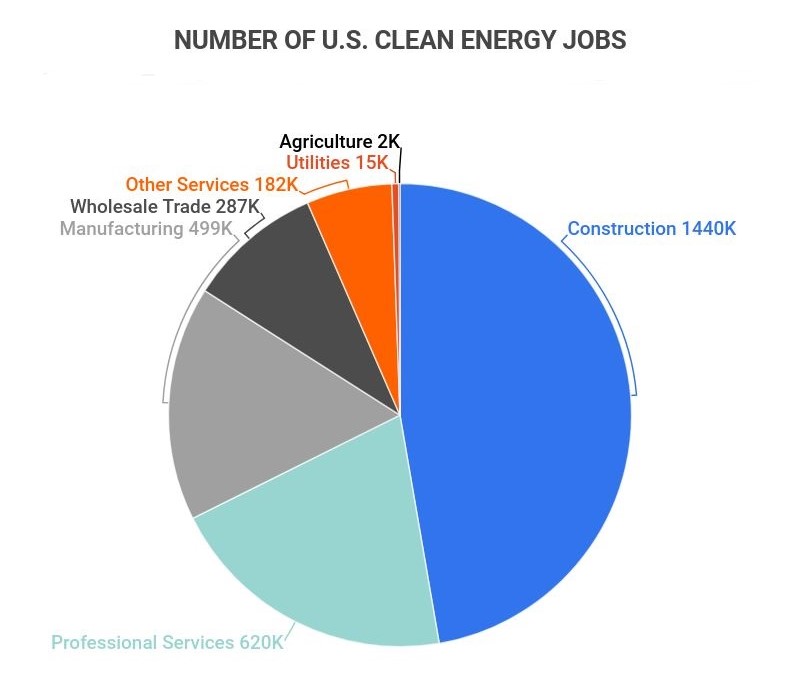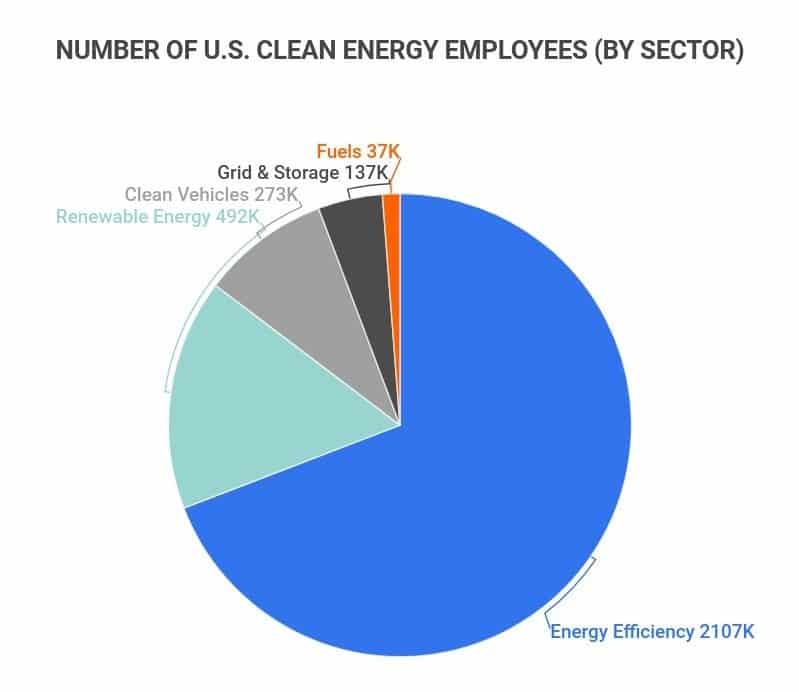- Tech Industry Statistics
- MFA Statistics
- Streaming Services Statistics
- Mobile Vs. Desktop Usage Statistics
- AI Statistics
- Live Streaming Statistics
- Zoom Meeting Statistics
- Cord Cutting Statistics
- Digital Transformation Statistics
- Virtual Reality Statistics
- How Fast Is Technology Advancing
- Mobile Commerce Statistics
- SaaS Statistics
- Machine Learning Statistics
- Diversity In High Tech
- Cyber Security Statistics
- Ecommerce Statistics
- Tech Industry
- Gaming Industry
- Renewable Energy Job Creation
- Smartphone Industry
- Cybercrime Statistics
- Amazon Statistics
- Personalization Statistics
Research Summary. Renewable energy is a hot topic in nearly every facet of U.S. culture and industry, influencing politics, retail products, construction, transportation, and fashion.
There is no doubt that clean energy is becoming a larger and larger part of the American economy. Here are some statistics on renewable energy jobs:
-
3.2 million Americans are employed by the clean energy sector as of 2022.
-
The US clean energy sector added over 300,000 new jobs to the market between 2020-2021.
-
The traditional fossil fuels sectors employs 1.2 million Americans.
-
The number of people employed by the traditional fossil fuels sectors in 2021 was down 10.4% from 2020.
-
As of 2017, renewable energy jobs made up 0.6% of the EU’s workforce and 0.4% of the U.S. workforce during the same year.
For further analysis, we broke down the data in the following ways:
Job | Energy Type and Subsector | Trends and Projections

General Renewable Energy Job Creation Statistics
-
California has the largest number of clean energy jobs, with 484,980 employed in this sector in 2020.
This makes up 3.01% of the state’s entire workforce. California jobs in the clean energy sector have also seen a growth of 2.2% from 2018 to 2020, with a 13.5% increase from June to December 2020.
This jump still hasn’t made up for the number of clean energy jobs lost in California due to the COVID-19 pandemic, but it shows that the state is on its way to full recovery as far as employment in this industry goes.
-
Nevada has seen a 38.9% increase in clean energy jobs from 2018 to 2020, the largest of any state.
Nevada’s clean energy sector employed about 31,191 people at the end of 2020, 2.49% of the state’s workforce.
Most of these jobs are in energy efficiency, but the state also has an especially high number of renewable energy, solar and wind, and storage and grid jobs, as most states have a larger margin between their energy efficiency jobs and the other job categories. Here is a breakdown of these categories for Nevada:
-
10,656 energy efficiency jobs
-
9,870 renewable energy jobs
-
9,209 storage and grid jobs
-
8,853 solar and wind jobs
-
-
Vermont’s clean energy employees make up 5.37% of its statewide workforce, the largest share of any state.
This is significantly higher than the national share of the workforce made up of clean energy employees: 2.2%.
Vermont employs 15,236 workers in the clean energy sector, the vast majority of which (10,069) work in energy efficiency.
Even though Vermont’s clean energy sector makes up a large amount of its workforce, it has only seen a 0.8% increase in clean energy jobs from 2018 to 2020.
-
There have been nearly 700 zero-energy buildings built in North America since 2000.
The rate at which these buildings are being constructed has increased exponentially over the past few years, seeing a 42% increase from 2018 to 2020.
Zero-energy buildings are structures that produce the same amount of renewable energy as they consume from traditional sources.
| State | % Of Job Growth (2018-2020) | Total Clean Energy Employment |
|---|---|---|
| Nevada | 38 | 31,191 |
| Louisiana | 11 | 26,393 |
| New Jersey | 10 | 50,096 |
| Oklahoma | 10 | 20,132 |
| West Virginia | 10 | 8,996 |
| Georgia | 9 | 71,111 |
| Florida | 9 | 149,624 |
| Pennsylvania | 9 | 87,313 |
| Colorado | 9 | 58,182 |
| Texas | 9 | 223,406 |
| State | % Share Of State Workforce | Total Clean Energy Employment |
|---|---|---|
| Vermont | 5 | 15,238 |
| Massachusetts | 3 | 108,909 |
| Maryland | 3 | 77,842 |
| Rhode Island | 3 | 13,874 |
| Wyoming | 3 | 8,042 |
| California | 3 | 484,980 |
| Oregon | 2 | 52,150 |
| Michigan | 2 | 113,456 |
| Delaware | 2 | 11,979 |
| Indiana | 2 | 80,614 |

Renewable Energy Job Statistics

-
Tesla, Inc. is the largest renewable energy employer in the country, with 70,757 employees in 2021.
Tesla, which earns annual revenue of about $31.5 billion, is known for its work with electric cars, but it’s also heavily involved in developing better batteries for electricity storage as well as solar panels and roofs.
-
As of 2019, the median hourly wage of clean energy workers is 25% higher than the national median.
The clean energy median wage is $23.89 an hour, while the median wage across all industries is $19.14 an hour.
Within the clean energy sector, those who work in wind energy earn the most, with a median hourly wage of $25.95, while those who work in advanced biofuels earn the least, with a median wage of $19.55 an hour.
-
About 25% of U.S. counties considered fossil fuel hubs also have greater potential for wind and solar energy production.
Counties are considered fossil fuel hubs if they have more than 486 jobs in the industry, putting them at the top 20% of all U.S. counties in this area.
Using spaces for renewable energy that are already being used for fossil fuels would make it easier for fossil fuel workers to switch over to renewable energy jobs, something that many clean energy companies are often eager to assist with.
Renewable Energy Job Creation Statistics By Energy Type and Subsector
-
Solar energy employed 316,675 people at the end of 2020, the most of any renewable energy source.
This is approximately 10.6% of the clean energy workforce. The area with the next highest number of employees is wind energy, with 116,817 workers.
Geothermal energy projects employ 8,002 workers, bioenergy/CHP has 40,146, and low-impact hydro has 11,251.
-
Geothermal energy is the fastest growing renewable energy subsector, with a job growth rate of 10.9% from 2017 to 2020.
Bioenergy/CHP has been growing jobs at a rate of 9.8% and wind energy at 6.8%, while solar energy employment has been shrinking by 1.4% during this period.
-
The plug-in hybrid vehicles subsector has seen a 28.1% increase in jobs from 2017 to 2020, the largest employment growth rate of any clean energy subsector.
As of 2020, the plug-in hybrid vehicles subsector employed 47,842 workers.
The subsector with the next highest employment growth rate is clean energy storage, growing at 19.2%.
| Subsector | # Of Employees In 2020 |
|---|---|
| Trad. HVAC | 531,640 |
| High Efficiency HVAC | 498,863 |
| Energy STAR | 490,717 |
| Advanced Materials | 324,060 |
| Solar | 316,675 |
| Hybrid Electric Vehicles | 119,638 |
| Wind | 116,817 |
| Electric Vehicles | 83,733 |
| Clean Storage | 78,040 |
| Plug-In Hybrid Vehicles | 47,842 |
Renewable Energy Job Creation Trends and Projections
-
From 2015 to 2019, clean energy jobs increased 70% faster than the total nationwide job growth rate.
The industry was adding jobs at a 10.4% rate in 2019, while the overall economy was adding them at a 6.1% rate.
These rates dropped off sharply in 2020 at the onset of the COVID-19 pandemic, even though both were expected to keep increasing throughout 2020 in the absence of the pandemic.
-
From June to December 2020, clean energy jobs saw a growth rate of 10.7%.
This is after a decline of 17.9% from March to May 2020 due to shutdowns in response to the COVID-19 pandemic. 601,252 people in the clean energy industry lost their jobs during these three months.
The projected job growth rate for the industry in 2020 before the pandemic was 5.3%.
-
Wind turbine service technician and solar photovoltaic installer jobs are projected to be the fastest-growing occupations over the next decade.
The growth rate of all occupations in the U.S. is predicted to be 3.7% from 2019 to 2029. Wind turbine service technicians and solar photovoltaic installers, on the other hand, are predicted to grow at a rate of 60.7% and 50.5%, respectively, during this time frame.
If this prediction is correct, together, these two occupations will add about 10,400 new jobs to the U.S. economy by 2029.
Renewable Energy Job Creation FAQ
-
How many jobs are available in energy?
In the US there are 7.8 million jobs available in the energy sector. This shows significant growth between 2020-2021 alone, with an increase from 7.5 million jobs to 7.8 million (4% increase).
-
Which renewable energy source is creating the most jobs?
Geothermal energy is the renewable energy source creating the most jobs. It saw an employment increase of 10.9% from 2017 to 2020.
-
What are examples of jobs in renewable energy?
There are many examples of jobs in renewable energy, as jobs can relate to wind, solar, hydro, electric, or other forms of power. Electricity generation and energy-saving manufacturing, construction, and transportation jobs are just a few examples of jobs in the industry.
Within these categories are positions such as wind turbine technicians, fuel cell technology chemists, and home weatherization technicians, to name just a few.
-
Do renewables create jobs?
Yes, renewables create jobs. On average, the renewable energy sector has added approximately 95,000 jobs to the market each year between 2017 and 2019.
-
How fast are renewable energy jobs growing?
From 2015 to 2019, renewable energy jobs grew 70% faster than the total nationwide job growth rate. Between June and December of 2020, renewable energy jobs experienced a growth rate of 10.7%. So, the renewable energy job sector is growing at an incredibly fast rate.
-
Is renewable energy a good career?
Yes, renewable energy is a good career with many opportunities. The renewable energy sector is growing very fast, and there is a huge demand for qualified employees across the field.
Governments around the world are showing increasing support for the renewable energy sector as well, promising continued growth in the long term for individuals who choose this field as a career.
-
Which energy source creates the most jobs per unit of energy produced?
The energy source that creates the most jobs per unit of energy produced is photovoltaic solar (PV). This energy source uses solar cells to convert sunlight directly into electricity.
Conclusion
Although it’s wrapped in controversy at times, there is no denying that the clean energy industry is growing rapidly with no slowdown in sight.
The COVID-19 pandemic may have derailed the industry’s projected 5.3% growth rate for 2020, causing a decline of 17.9% instead, but clean energy rebounded rapidly and grew by 10.7% in the remaining months of 2020.
Jobs in the industry are predicted to continue increasing, and the U.S. Bureau of Labor Statistics projects growth rates of 60.7% and 50.5% for certain wind and solar energy jobs from 2019 to 2020, far higher than the predicted nationwide rate of 3.7% during that same time frame.
References
-
E2. “Clean Jobs America 2021.” Accessed on September 22, 2021.
-
New Buildings Institute. “Zero Energy-Verified Commercial Buildings More Than Double Since 2018.” Accessed on September 22, 2021.
-
Green Citizen. “10 Largest Renewable Energy Stocks To Add to Your Portfolio in 2021.” Accessed on September 22, 2021.
-
E2. “Clean Jobs, Better Jobs.” Accessed on September 22, 2021.
-
Brookings. “How Renewable Energy Jobs Can Uplift Fossil Fuel Communities and Remake Climate Politics.” Accessed on September 22, 2021.
-
Clean Choice Energy. “Renewable Energy Jobs for Fossil Fuel Workers.” Accessed on September 22, 2021.
-
E2. “Clean Jobs America 2020.” Accessed on September 22, 2021.
-
U.S. Bureau of Labor Statistics. “Solar and Wind Generation Occupations: A Look at the Next Decade.” Accessed on September 22, 2021.
-
Office of Energy Efficiency and Renewable Energy. “Explore Clean Energy Careers.” Accessed on September 22, 2021.
- Tech Industry Statistics
- MFA Statistics
- Streaming Services Statistics
- Mobile Vs. Desktop Usage Statistics
- AI Statistics
- Live Streaming Statistics
- Zoom Meeting Statistics
- Cord Cutting Statistics
- Digital Transformation Statistics
- Virtual Reality Statistics
- How Fast Is Technology Advancing
- Mobile Commerce Statistics
- SaaS Statistics
- Machine Learning Statistics
- Diversity In High Tech
- Cyber Security Statistics
- Ecommerce Statistics
- Tech Industry
- Gaming Industry
- Renewable Energy Job Creation
- Smartphone Industry
- Cybercrime Statistics
- Amazon Statistics
- Personalization Statistics





